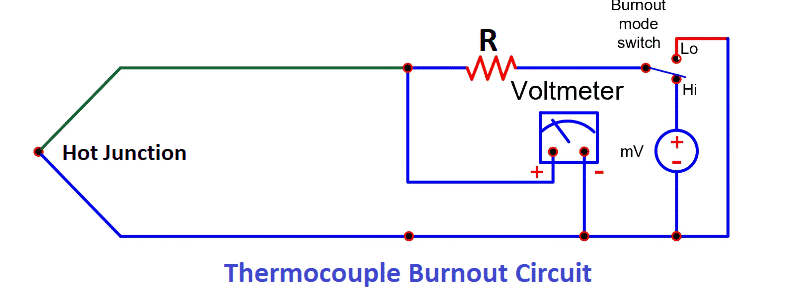Thermocouple burnout detection is very important for ensuring no tripping of the plant if the thermocouple sensor opens. The thermocouple has two dissimilar materials joined at one end and its other end is open. At the open end, voltage produces according to the temperature at the close end. The burnout of the thermocouple means its hot junction opens. The thermocouple can not function if its hot junction is an open circuit.
Reasons for thermocouple burnout
The thermocouple burnout problem may arise because of the following reasons.
- The temperature at the hot junction is more than the specified temperature may cause burn out of the element materials. In this case, the thermocouple gets an open circuit.
- The compensation cable used between the hot junction and cold junction is open.
- Cutting/welding/ chipping work in the vicinity of the compensation cable may cause damage to the cable.
- Last but not least, the aging of thermocouples may contribute to thermocouple burnout.
Consequences of thermocouple burnout
The following consequences may happen in the case of thermocouple burnout.
- The thermocouple burnout causes a high impedance of the circuit. It is possible that the surrounding electric noise of power lines, VFD, and the electric motor may link to thermocouples. It causes erroneous temperature readings & further it causes unstable process operation and the plant tripping.
- The false temperature reading misleads the process operator. The operator’s corrective action on the basis of this reading may cause a serious hazard as well.
How to mitigate the thermocouple burnout problem?
It is not possible to solve the thermocouple burnout problem, but it is possible to output a burnout status of the thermocouple. The burnout indication facilitates the operator to take appropriate action for process control, and it also facilitates instrument mechanics to replace the defective thermocouple.
The thermocouple instrument generates a consistent state if the thermocouple circuit is open. This feature is called the burnout mode of a thermocouple instrument.
Thermocouple burnout detection system
The thermocouple circuit with the burnout feature is shown below.

Case 1: When the thermocouple circuit is complete
When the thermocouple circuit is complete, the mill-volt generated at the cold junction is proportional to the temperature difference between the hot and cold junction. The voltmeter shows the process temperature. The burnout detection circuit has a voltage source and a high-value resistance connected in the series with the voltage source and the voltmeter.
The resistance value is in the range of mega-ohm. The infinitesimal current flow through the high-value resistance, and thus the measurement error due to the burnout detection circuit is negligible.
Case 2: When the thermocouple circuit is open
When the thermocouple or thermocouple circuit gets open, no voltage induces across the voltmeter. Now, the current completes its path through the voltage source, resistance, and voltmeter. The voltage across the voltmeter may be high or low depending on the selection of burnout switch.
We can select the meter to read high or low through the SPDT switch. When SPDT switch selection is at a high position, the voltmeter reads high, and when SPDT switch selection is at a low position, the voltmeter reads low. The detection of high or low voltage on thermocouple open conditions can be configured in the PLC. The programmable logic controller (PLC ) outputs a thermocouple burnout signal on the SCADA.
Thus, it is possible to detect the thermocouple functionality with the help of a thermocouple burnout circuit.
Read Next: